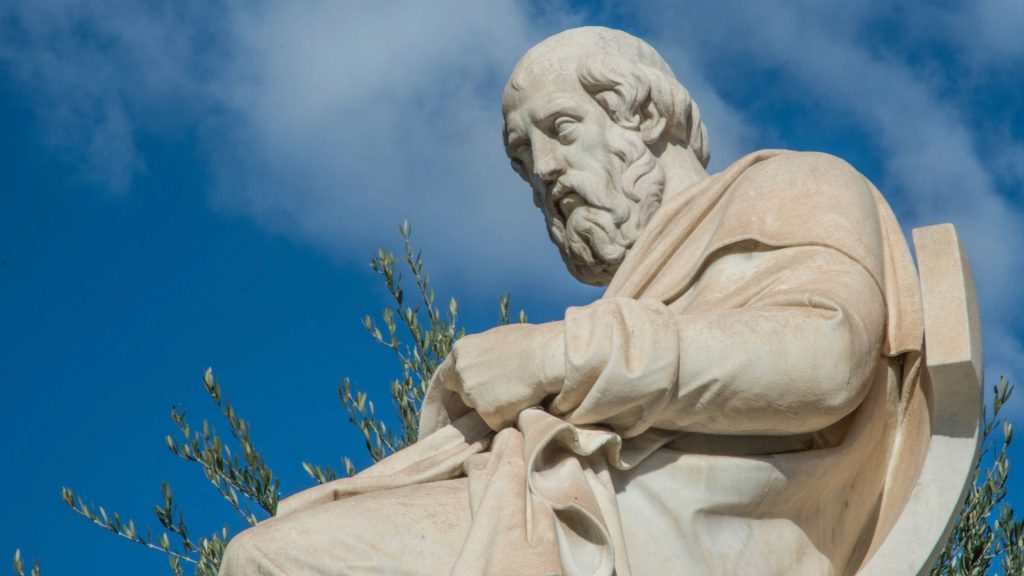Plato, a famed student of Socrates and a teacher of Aristotle, is regarded as one of the most influential and prominent Greek philosophers of his time. He was born around 427 BCE and passed away around 348 or 347 BCE. His exact burial place has been unknown for nearly 2,400 years, but researchers finally have an answer.
Charred Papyrus Found In Herculaneum
In the 1700s, researchers discovered a library inside a villa in the ancient Roman town of Herculaneum, located in the modern-day comune of Ercolano, Campania, Italy. The villa was believed to have been owned by Julius Caesar’s father-in-law.

The Villa of the Papyri, as it was named, contained roughly 2,000 papyrus scrolls, each offering an inside look at life in Ancient times. In a perfect world, we would be able to translate and learn from the scrolls—but there’s one little problem.
Herculaneum Was Destroyed In A.D. 79
Most of us have heard of the story of Pompeii and how it was destroyed in a cataclysmic eruption of the volcano on Mt. Vesuvius in A.D. 79, but it wasn’t the only town decimated by lava. Herculaneum – as well as Stabiae and Oplontis – were also destroyed.

According to The Herculaneum Society, the lave was roughly 400 degrees when it reached the town. While it killed anyone who hadn’t already evacuated, it was hot enough to carbonize organic materials – including the papyri in the villa.
Papyrus Contained Writings Of Philodemus
One of those scrolls – which is carbonized but too fragile to open – is believed to include the writings of Philodemus of Gadara, an Epicurean philosopher who lived between 110 and 38 BCE and was known for his studies in Athens and Italy.

The scroll, titled History of the Academy, documents the life and death of Plato and details the history of Plato’s Academy – one of the world’s first universities. But since the scroll was charred and fragile, the exact contents of the scroll were hidden.
Plato’s Academy Was Founded In 387 BCE
Sometimes referred to as the Platonic Academy and the Academic School, Plato’s Academy was founded by the man himself (Plato). Historians don’t know the exact year it was founded, but they estimate it to be around 387 BCE when he returned from a visit to Sicily.

The Academy was open to the public and Plato never charged a membership, but most of its scholars were upper-class men. It’s where Plato taught Aristotle for more than two decades – before Aristotle started his own school.
The Academy Was Destroyed In 86 BCE
Plato passed away roughly four decades after The Academy was founded. He was succeeded by a revolving door of philosophers, who kept the academy going for another 250 years. Of course, all good things must come to an end.

Things took a turn for the worse when the First Mithridatic War began in 88 BC. Two years later, Lucius Cornelius Sulla invaded Athens and destroyed everything in his path – including the academy. Unfortunately, the damage was so severe that it couldn’t be repaired or fixed.
Historians Knew Plato Was Buried At The Academy
Up until this year, historians knew Plato was buried somewhere at The Academy – a fitting resting place for one of the most popular philosophers of all time – but they didn’t have an exact location.

That’s where the charred scrolls come into play. Historians knew the importance of what was hidden in the writings, but they didn’t have any way of opening the scrolls or deciphering the contents inside – well, that is, until recently.
Use Artificial Intelligence To Decipher Scroll
In an effort to reveal what was inside the scroll, historians enlisted the help of scientists around the world. Student researchers everywhere started using infrared and ultraviolet optical imaging, thermal imaging, tomography, and artificial intelligence to decipher the contents.

As of now, more than 1,000 words have been deciphered, accounting for about one-third of the text in the scroll – which is being preserved inside the National Library of Naples. Here’s what historians have learned so far:
3. Plato Was Buried In A Garden Reserved For Him
Perhaps the most interesting, exciting, and historical discovery was the exact location of Plato’s burial site. As we mentioned earlier, they already knew he was buried at The Academy, but didn’t know where on the property he was laid to rest.

“Among the most important news, we read that Plato was buried in the garden reserved for him (a private area intended for the Platonic school) of the Academy in Athens, near the so-called Museion or sacellum sacred to the Muses,” the researchers wrote.
2. Plato Was Sold Into Slavery Earlier Than We Thought
It has been well-documented that Plato spent most of his later years as a slave. Historians initially believed this occurred around 387 BCE, but the scroll suggests it happened roughly 10-20 years earlier – between 404 and 399 BCE.

At the time, Plato was getting involved in the politics of Syracuse – a city in Sicily. Things took a turn for the worse when one of Plato’s disciples turned on him. He originally faced death, but was eventually sold into slavery.
1. Plato Didn’t Like Barbarian Musicians from Thrace
The group of student researchers also deciphered a piece of dialogue between two characters. Plato apparently wasn’t impressed with the musical and rhythmic abilities of a barbarian musician from Thrace.

Thrace is a region in Southeast Europe that includes present-day southeastern Bulgaria, northeastern Greece, and the European part of Turkey. In Ancient times, the people of this region were described as ‘warlike’ and ‘barbarians.’
Not The First Time Researchers Used AI
Earlier in the year, researchers deciphered more than 2,000 words (5% of the text) of a different scroll as part of the Vesuvius Challenge. Like the other scroll, historians believe Philodemus was behind the text – which talked about seeking pleasure in life.

“In a way, it feels like building on my ancestors’ innovative spirit from 5,000 years ago with their invention of Papyrus sheets,” said one of the winners. “By bringing an ancient scroll back from the ashes, we continue to celebrate and document the incredible story of human ingenuity.”
Researchers Won $700,000 For Discovery
A three-person team—Youssef Nader, Luke Farritor, and Julian Schilliger—deciphered the scroll, and they were handsomely rewarded for their hard work, to the tune of $700,000. If split evenly, they’ll each earn roughly $235,000.

And their discovery will continue to pay dividends in the future. Let’s not forget that there are more than 1,800 additional scrolls that researchers would love to decipher. I mean, just think about all the history contained in those scrolls!






